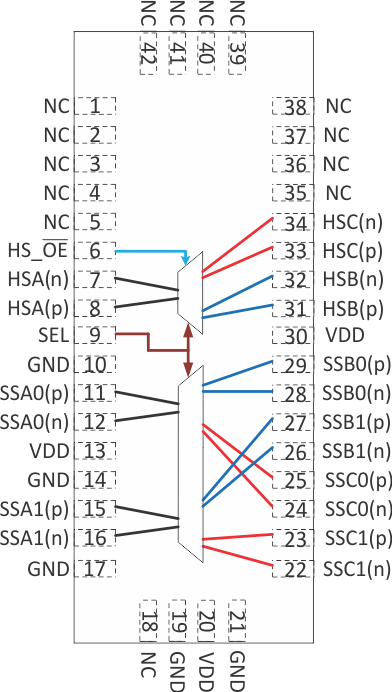SLAS975A November 2013 – August 2015 HD3SS6126
PRODUCTION DATA.
- 1 Features
- 2 Applications
- 3 Description
- 4 Revision History
- 5 Pin Configuration and Functions
- 6 Specifications
- 7 Detailed Description
- 8 Application and Implementation
- 9 Power Supply Recommendations
- 10Layout
- 11Device and Documentation Support
- 12Mechanical, Packaging, and Orderable Information
Package Options
Mechanical Data (Package|Pins)
- RUA|42
Thermal pad, mechanical data (Package|Pins)
- RUA|42
Orderable Information
7 Detailed Description
7.1 Overview
The HD3SS6126 is a USB 3.0 and USB 2.0 differential switch, it is designed to support data rates up to 10 Gbps on high-bandwidth paths (SS), it is also suitable for DisplayPort, PCIe Gen1/2/3, SATA 1.5/3/6G, SAS 1.5/3/6G and XAUI applications. The device uses a unique adaptation method to maintain a constant channel impedance over the supported common-mode voltage range, resulting in an excellent high-bandwidth path dynamic characteristics (at 2.5 GHz; Crosstalk = –35 dB, Isolation = –23 dB, Insertion Loss = –1.1 dB, Return Loss = –11 dB).
7.2 Functional Block Diagram

7.3 Feature Description
The HD3SS6126 can be powered by VBUS from the USB Host, and is capable of selecting USB2 independently from USB3. Although the main application of the HD3SS6126 is USB3.0/2.0, the device also supports common interfaces such as PCIe Gen1 and Gen2, DP and SATA/SAS applications. The device is able to support these additional interfaces because of its support of data rates up to 5.4 Gbps and common-mode voltages from 0 V to 2 V with a maximum signal swing of 1.8 V. All of these applications use an 8b or 10b coding technique to achieve DC balance and facilitate terminal equipment.
NOTE
The device may need AC capacitors and additional bias voltage to support the PCIe Gen1 and Gen2 interfaces.
7.4 Device Functional Modes
Table 1. Truth Table USB 3.0 SuperSpeed USB
| SEL | USB 3.0 PORT SELECTION | ||
|---|---|---|---|
| SSA0/1 | SSB0/1 | SSC0/1 | |
| 0 | To/From SSB0/1 | To/From SSA0/1 | Off |
| 1 | To/From SSC0/1 | Off | To/From SSA0/1 |
Table 2. Truth Table USB 2.0 High-Speed, Full-Speed, Low-Speed Path
| HS_OE | SEL | USB 2.0 Port Selection | ||
|---|---|---|---|---|
| HSA | HSB | HSC | ||
| 0 | 0 | To/From HSB | To/From HSA | Off |
| 0 | 1 | To/From HSC | Off | To/From HSA |
| 1 | X | Off | Off | Off |